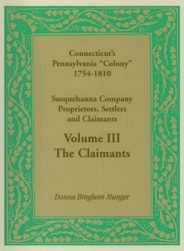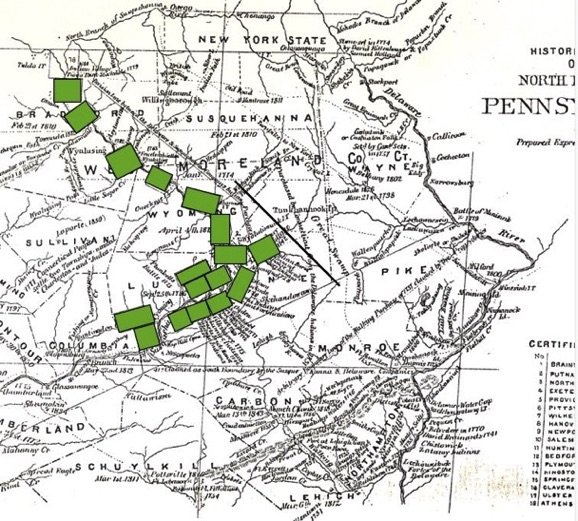Connecticut’s
Pennsylvania “Colony”
1754-1810
Susquehanna Company
Proprietors, Settler
and Claimants
Volume III
The Claimants
Between 1753 and 1800, the Connecticut based Susquehanna Company appropriated and settled land in northeastern Pennsylvania contrary to Pennsylvania law. Eventually the Company failed, but over 1100 Connecticut proprietors and settlers retained a vested interest in Pennsylvania land. Who they were and which ones remained in Pennsylvania to become Connecticut Claimants is the question that this database will answer.
Two previous database volumes in this set document proprietors and settlers: Connecticut’s Pennsylvania “Colony,” Susquehanna Company Proprietors and Connecticut’s Pennsylvania “Colony,” Susquehanna Company Settlers. This volume documents claimants. Sources come from official Pennsylvania Land Office records now in the Pennsylvania State Archives in Harrisburg.
As a result of the only court case tried under Article IX of the Articles of Confederation, Connecticut and the Susquehanna Company lost jurisdictional control of the area the Company claimed in Pennsylvania. After December 30, 1782, the date of the court decision, Pennsylvania assumed political control. The court expressed sympathy for the Connecticut settlers and admonished Pennsylvania to proceed justly. Twenty years ensued before overlapping Pennsylvania speculators and Connecticut settlers reached satisfactory agreement. At first, Pennsylvania offered settlers in the seventeen Company townships granted, surveyed, and settled before December 30, 1782 an opportunity to become certified claimants if they could prove a chain of title from before that date. Later, settlers only needed to prove that they had obtained their land under the rules and regulations of the Susquehanna Company. Certification meant a legal patent to the tract, but it also meant purchasing one’s land all over again, this time from Pennsylvania.
Use worldcat.org to find Volume III, The Clamaints, in a library near you.
Use heritagebooks.com or Amazon.com to buy Volume III. This is not advertising. In return for publication, I gave Heritage Books the royalty income, although I hold the copyright.
All Volumes (I, II, III) may be obtained in the same way.
To buy a searchable, archival quality, at cost, CD of Volumes I, II, III databases contact me. (dgbmunger@gmail.com)


From Alfred Mathews, ed. History of Wayne, Pike and Monroe Counties Pennsylvania. Philadelphia: R.T. Peck, 1886 Note: Athens was not a certified township
Records generated in the certifying process were recorded in several different Pennsylvania land office volumes. This database is constructed from these legal records. To locate and trace an individual from Susquehanna Company proprietor to settler to claimant, researchers will also want to consult the first two volumes in the set. By using all three volumes, elusive Connecticut ancestors who were involved with the Susquehanna Company in Pennsylvania will no longer be buried in the records. Of course not all proprietors became settlers and not all settlers became claimants. Should this be the case, the database will indicate the level of activity and approximately when an individual's Company interest ceased and the researcher should look elsewhere.
To access the alphabetical database of claimants: claimant’s name, township, drawer’s name, date acquired, lot number, acres, chain of title, patentee, patent book and page, survey book and page, source, you need to use this volume III.
Many drawers and claimants were original Susquehanna Company proprietors. Others were descendants of original proprietors and their chain of title usually includes familial relationships. Several claimants were land speculators who bought lots from settlers who could not afford to become claimants.
